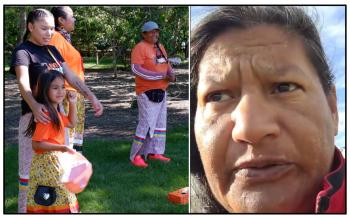Image Caption
Summary
Local Journalism Initiative Reporter
Windspeaker.com
Like many, Patricia Ballantyne, a member of the Peter Ballantyne Cree Nation, Sask., had a strong reaction to the discovery of the remains of hundreds of children in an unmarked grave at the site of a former residential school in Kamloops, B.C.
It sparked a need in her to do something. She decided to launch a walk from the site of the former residential school in Prince Albert to Ottawa. She calls it the Walk of Sorrow, and it has a growing following on Facebook.
“You've got to realize this is painful. Isn't just me, isn't just the kids who are lost. It's all through Canada. It's all through First Nations families and First Nations communities… Everything that happened in the residential schools,” said Ballantyne when making a stop in Regina on June 14 during the walk.
“They weren't heard, and given that love and sense of security,” Ballantyne said of the children lost.
“How are [the surviving students] supposed to give you love, security and affection when they didn't know what it was and they didn't have it? Our parents weren't taught that,” Ballantyne said of the intergenerational legacy of the residential school system in Canada.
Ballantyne’s team for the walk has been growing. It includes people who have committed to be with her for Walk of Sorrow until it reaches its destination in Ottawa.
One woman making the trek is 21-year-old Sasha Michel.
“I knew what they'd done to the children,” Michel said. “That really disappointed me, and it really hurt me in a way because both of my parents were in the residential school.
“It's just a lot. When I was young, I knew about it. As young as I remember, I knew about it.”
Also walking for part of the journey is Charlene Caribou, who hails from Melfort, Sask.
“I don't have all my ducks in a row yet to go to Ottawa. I definitely have a feeling it's helpful for everyone,” Caribou said shortly after arriving in Regina.
Her feelings about the Walk of Sorrow journey run deep.
“I'd like to encourage everybody to speak,” Caribou said. “Any kind of abuse that's happened to you, please, do not let it sit in your heart.” She recommended that people acknowledge it.
Caribou went further to discuss the newly-revealed once-hidden history of residential schools in Canada.
“Acknowledge the knowledge of new knowledge. This knowledge needs to be passed on. And everybody needs to understand.”
Trudy Mercredi of the James Smith reserve was a former worker in the Prince Albert residential school, and had vivid memories from the staff side of the school. Mercredi worked at the school until its closure in 1997, and expected to take part in the walk as much as possible.
“I would always hug them,” she said of the students. “There were times like some will come to my house, and they wanted to live with me, and I told them no you can't live with me.”
“We made ribbon skirts and bundles and sweetgrass for them,” she said of Ballantyne’s team. “I think this whole thing that (Ballantyne’s) doing is helping the people as they walk. Even as we're walking people honk their horn and say ‘we love you’, and ‘you're making a difference’,” said Mercredi.
She said people who were showing up to take part in the walk lifted her spirits. “One of these young women… said she just had to come. And she brought her mom.” The young woman told her that everyone’s feelings would be left on the road. “And that's why I did it… I left it on the road.”
“When asked if she had any knowledge of children dying in residential schools, Mercredi answered, “My mom never talked about it. Nobody really ever talked about it.”
One person that spoke to Windspeaker.com that met Ballantyne in Regina for the walk explained why she thought former students were reluctant to speak about their experience and children’s deaths at the school.
“If children said anything, they would be threatened. Because of that, they would only tell you part of the story. That doesn't make it less true.
“This is a huge cover up,” the person said.
“They were trying to make little brown white men and women out of the children, the ones they allowed to live. It's pure and simple genocide.”
Ballantyne said “It's time that Canadian society accepts what the government did to take away our culture, energy and our language...to understand that what they did was very detrimental to our nations, and how they separated our families. There were community breakdowns. It’s time we started fixing things up.”
The youngest walker so far during the walk was Neveya Constant, age 7.
“It's kind of nice, and I walk with my mum,” said said.
Courtney Constant, Neveya’s mother, hopes the walk will “make sure every voice is heard and to initiate all the support [Ballantyne] can get.”
To learn more about the Walk of Sorrow, go to their Facebook page at https://www.facebook.com/groups/337465634463813

